
Lobsters are malacostracans of the family Nephropidae or its synonym Homaridae. They have long bodies with muscular tails and live in crevices or burrows on the sea floor. Three of their five pairs of legs have claws, including the first pair, which are usually much larger than the others. Highly prized as seafood, lobsters are economically important and are often one of the most profitable commodities in the coastal areas they populate.

The Caridea, commonly known as caridean shrimp or true shrimp, from the Greek word καρίς, καρίδος, are an infraorder of shrimp within the order Decapoda. This infraorder contains all species of true shrimp. They are found widely around the world in both fresh and salt water. Many other animals with similar names – such as the mud shrimp of Axiidea and the boxer shrimp of Stenopodidea – are not true shrimp, but many have evolved features similar to true shrimp.

Homarus is a genus of lobsters, which include the common and commercially significant species Homarus americanus and Homarus gammarus. The Cape lobster, which was formerly in this genus as H. capensis, was moved in 1995 to the new genus Homarinus.

Porcelain crabs are decapod crustaceans in the widespread family Porcellanidae, which superficially resemble true crabs. They have flattened bodies as an adaptation for living in rock crevices. They are delicate, readily losing limbs when attacked, and use their large claws for maintaining territories. They first appeared in the Tithonian age of the Late Jurassic epoch, 145–152 million years ago.

Astacidea is an infraorder of decapod crustaceans including lobsters, crayfish, and their close relatives.

The Cape lobster, Homarinus capensis, is a species of small lobster that lives off the coast of South Africa, from Dassen Island to Haga Haga. Only a few dozen specimens are known, mostly regurgitated by reef-dwelling fish. It lives in rocky reefs, and is thought to lay large eggs that have a short larval phase, or that hatch directly as a juvenile. The species grows to a total length of 10 cm (3.9 in), and resembles a small European or American lobster; it was previously included in the same genus, Homarus, although it is not very closely related to those species, and is now considered to form a separate, monotypic genus – Homarinus. Its closest relatives are the genera Thymops and Thymopides.
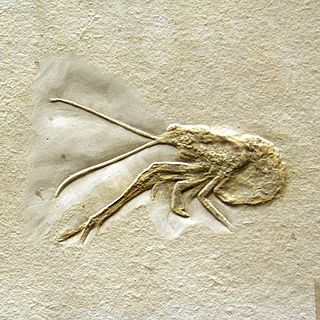
Glypheidea is an infraorder of lobster-like decapod crustaceans, comprising a number of fossil forms and the two extant (living) genera Neoglyphea and Laurentaeglyphea: The infraorder was thought to be extinct until a living species, Neoglyphea inopinata, was discovered in 1975. They are now considered "living fossils", with over 256 fossil species discovered, and just two extant species.

Mecochirus is an extinct genus of lobster-like decapod crustaceans, containing 17 species. The Maxberg Specimen of Archaeopteryx was initially assigned to the type species, Mecochirus longimanatus before it was realised that it belonged to Archaeopteryx lithographica.

Erymidae is a family of decapod crustaceans known only from fossils. They survived for 100 million years, from the Permo-Triassic boundary to the Albian. Eleven genera are recognised:

Acanthochirana is an extinct genus of prawn that existed during the upper Jurassic period. It was named by E. Strand in 1928, and its type species is Acanthochirana cordata. They are distinguished from the related genus Aeger by the presence of teeth on the rostrum, which are absent in Aeger.

Hakelocaris vavassorii is an extinct species of prawn belonging to the family Penaeidae. It was named in 1994 by Alessandro Garassino, and is the only species in the genus Hakelocaris.
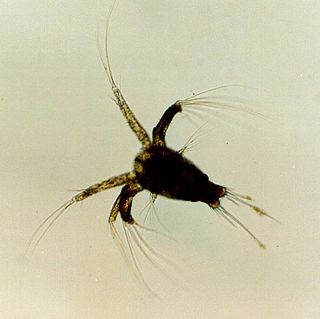
Crustaceans may pass through a number of larval and immature stages between hatching from their eggs and reaching their adult form. Each of the stages is separated by a moult, in which the hard exoskeleton is shed to allow the animal to grow. The larvae of crustaceans often bear little resemblance to the adult, and there are still cases where it is not known what larvae will grow into what adults. This is especially true of crustaceans which live as benthic adults, more-so than where the larvae are planktonic, and thereby easily caught.
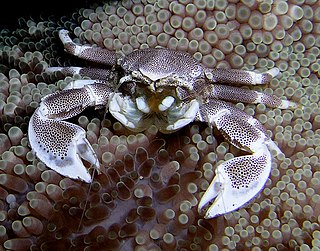
The Galatheoidea are a superfamily of decapod crustaceans comprising the porcelain crabs and some squat lobsters. Squat lobsters within the three families of the superfamily Chirostyloidea are not closely related to the squat lobsters within the Galatheoidea. The fossil record of the superfamily extends back to the Middle Jurassic genus Palaeomunidopsis.
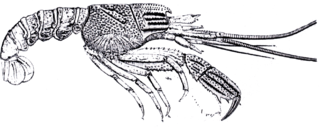
Glyphea is a genus of fossil glypheoid crustaceans that lived from the Jurassic to the Eocene. It includes the following species:

Cancrinos is a genus of fossil crustaceans closely allied with the slipper lobsters. One species is known, C. claviger from the Jurassic of southern Germany.

Hoploparia is a genus of fossil lobster belonging to the family Nephropidae. The type species of this genus is Hoploparia longimana.
Hjoula is a municipality in the Byblos District of Keserwan-Jbeil Governorate, Lebanon. It is 70 kilometres (43 mi) north of Beirut. Hjoula has an elevation of between 920 and 1,100 m above sea level. Hjoula has a total land area of 528 hectares. The village of Hjoula is known for its fertile soil and its woods, as well as Late Cretaceous fossils.
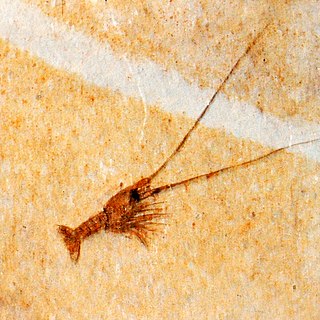
Palinurina is an extinct genus of crustaceans, belonging to the decapods. These animals lived between the Lower Jurassic and the Upper Jurassic and their fossils can be found in Europe. This crustacean is considered one of the oldest lobsters.
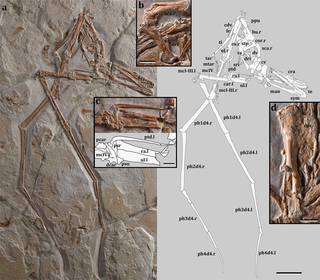
Mimodactylus is a genus of istiodactyliform pterosaur that lived in what is now Lebanon during the Late Cretaceous, 95 million years ago. The only known specimen was discovered in a limestone quarry near the town of Hjoula, belonging to the Sannine Formation. The owner of the quarry allowed the specimen to be prepared and scientifically described by an international team of researchers. When it was eventually sold, the buyer donated it to the MIM Museum in Beirut. In 2019, the researchers named the new genus and species Mimodactylus libanensis; the generic name refers to the MIM Museum, combined with the Greek word daktylos for "digit", and the specific name refers to Lebanon. The well-preserved holotype specimen is the first complete pterosaur from the Afro-Arabian continent, and the third pterosaur fossil known from Lebanon.

Pseudastacus is an extinct genus of decapod crustaceans that lived during the Jurassic period in Europe, and possibly the Cretaceous period in Lebanon. Many species have been assigned to it, though the placement of some species remains uncertain and others have been reassigned to different genera. Fossils attributable to this genus were first described by Georg zu Münster in 1839 under the name Bolina pustulosa, but the generic name was changed in 1861 after Albert Oppel noted that it was preoccupied. The genus has been placed into different families by numerous authors, historically being assigned to Nephropidae or Protastacidae. Currently, it is believed to be a member of Stenochiridae.


















